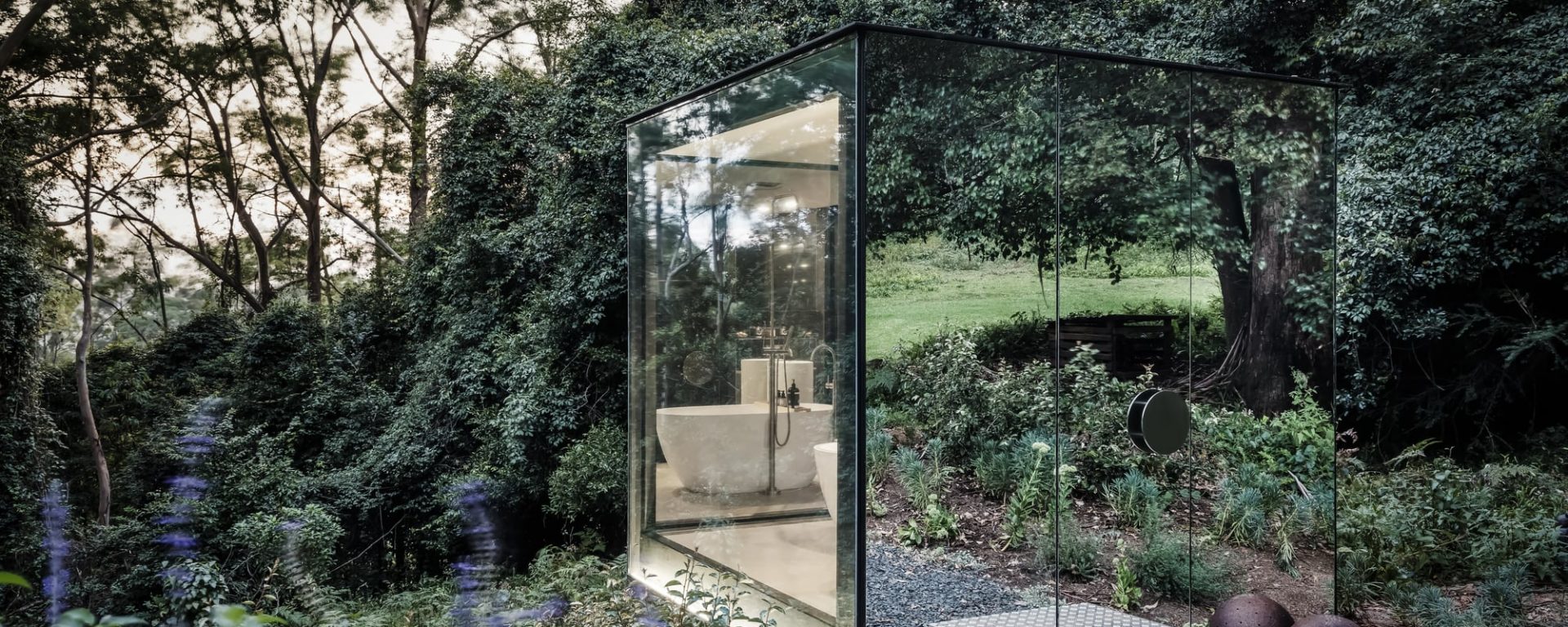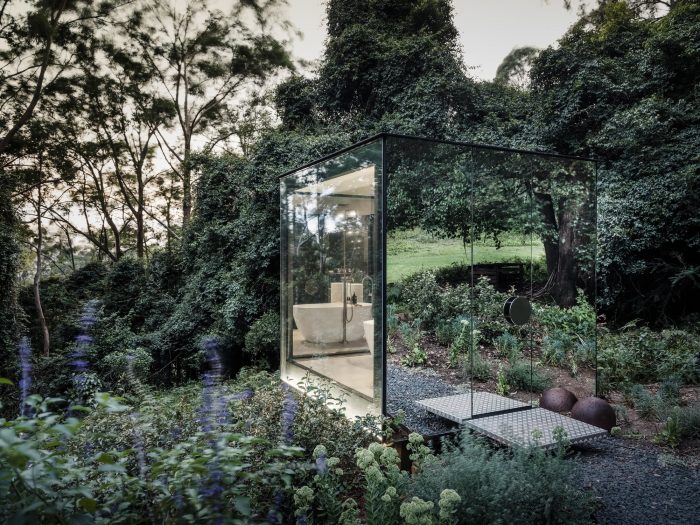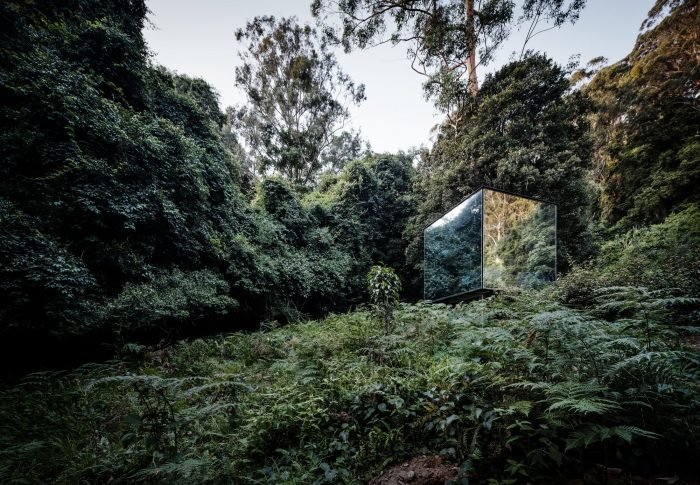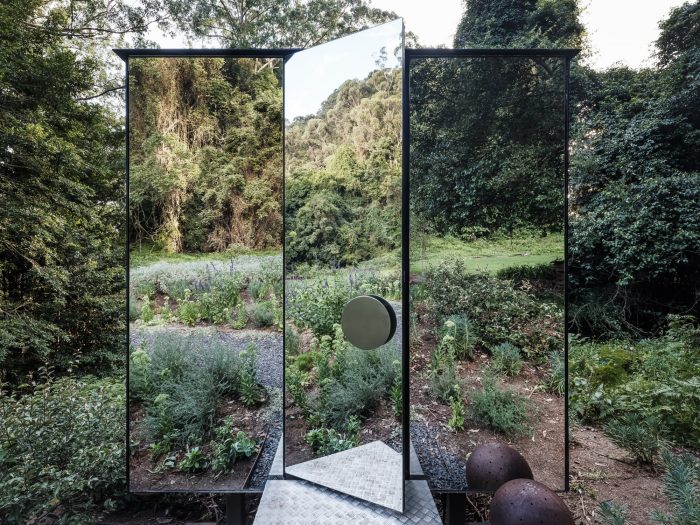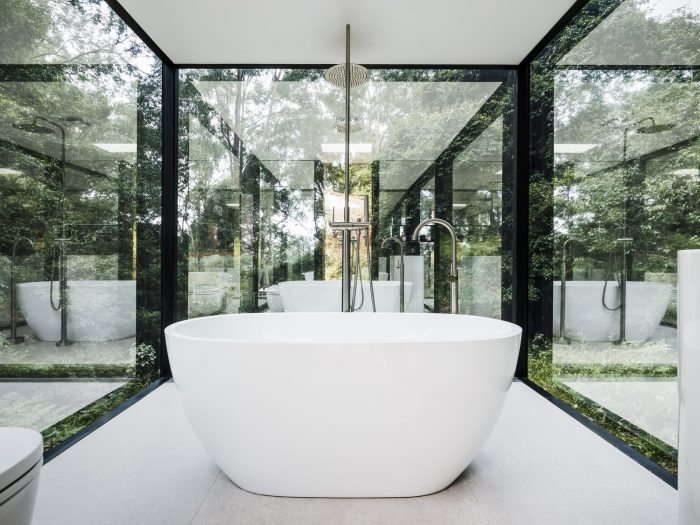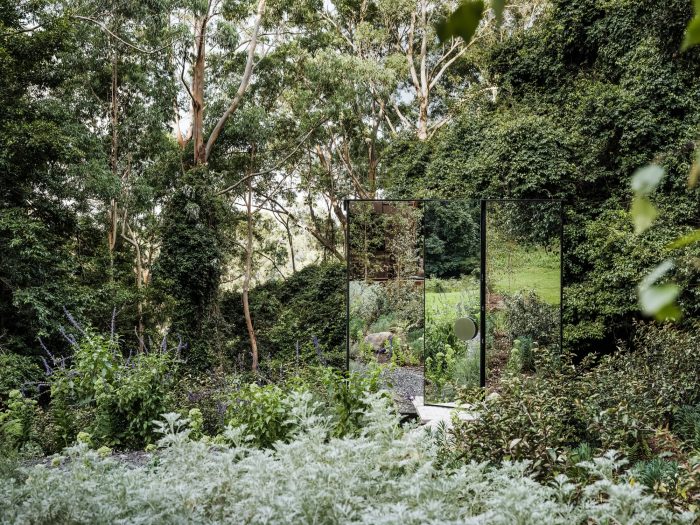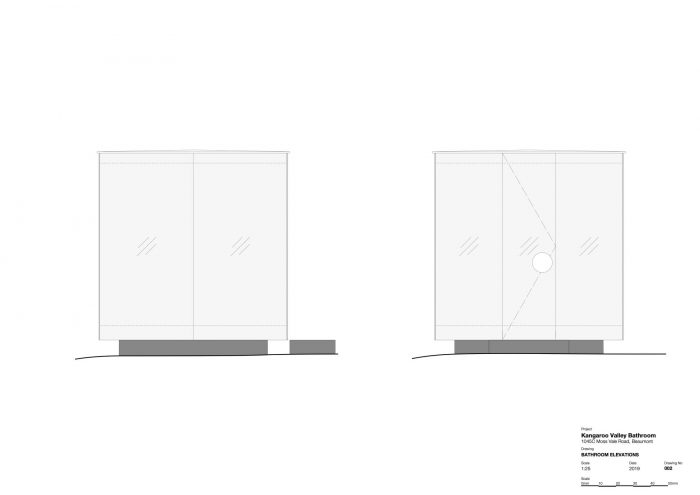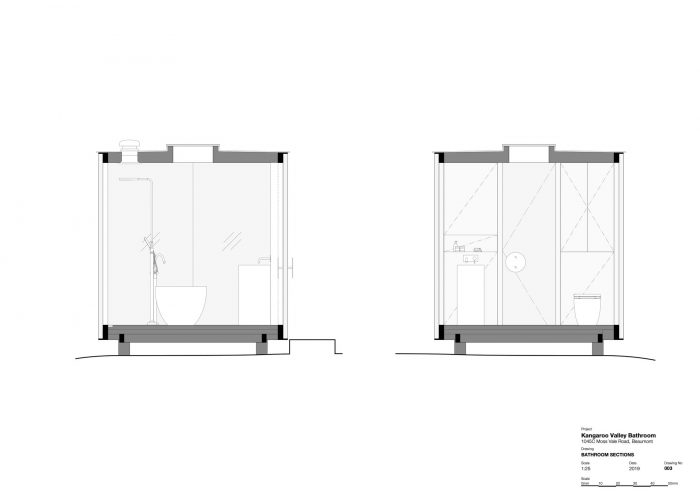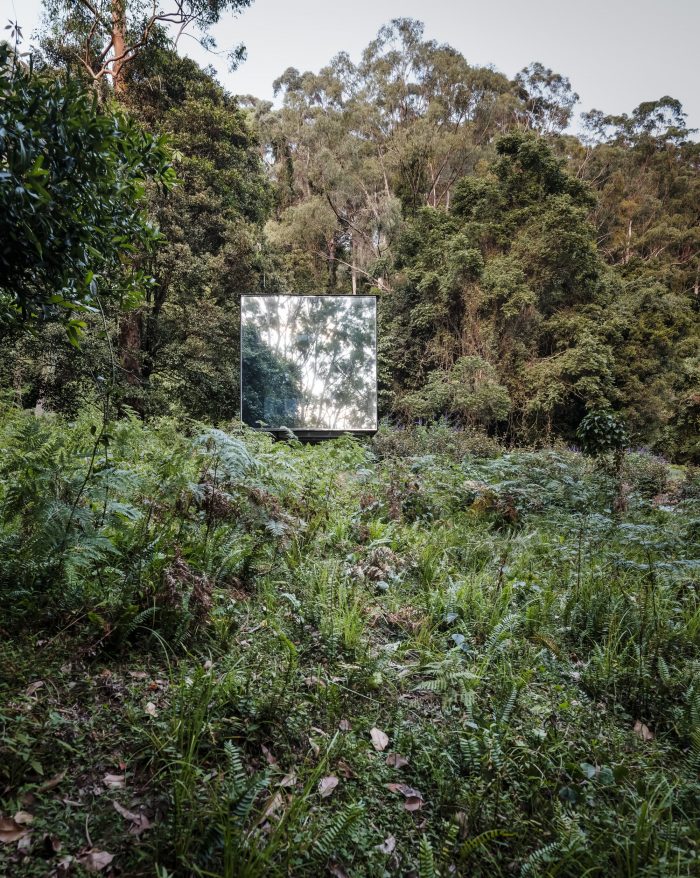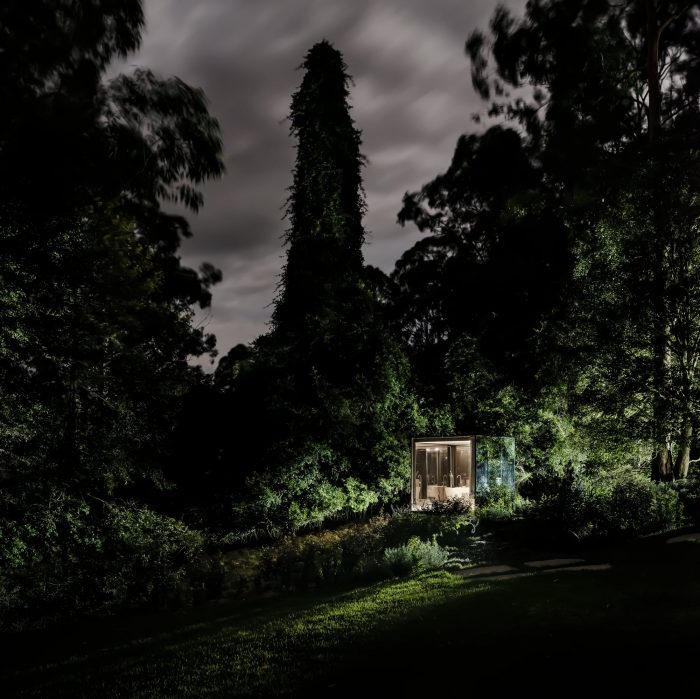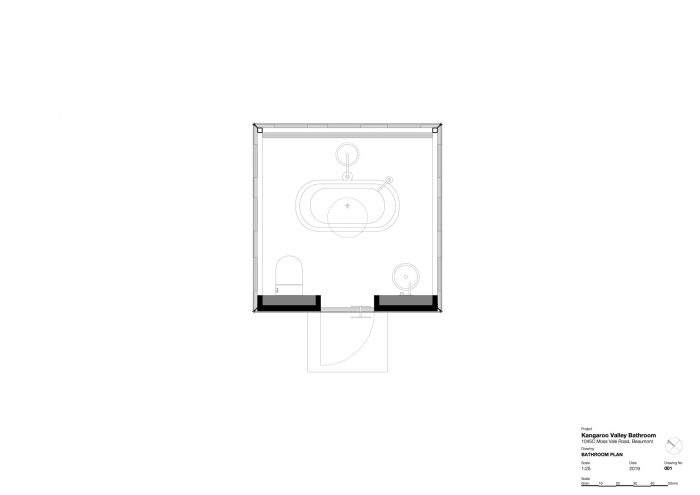袋鼠谷厕所是丛林中的一个卫生间,为过夜的小木屋提供服务。其概念是将浴室与小屋分开,模仿露营的体验。浴室/外屋位于山坡上,距离住宿区约30米,通过一条小路进入,穿过一片茂密的景观。它是一个镜面立方体,高于现有地面,依偎在植被中。外屋的结构在白天完全消失了。它反映了郁郁葱葱的景观,只有立方体边缘的微妙线条在视觉上清晰可见。当在浴室里时,墙壁都是玻璃,对周围景观的视野没有任何阻碍。
The Kangaroo Valley Outhouse is a bathroom in the bush which services a small cabin for overnight stays. The concept was to separate the bathroom from the cabin and mimic the experience of camping. The bathroom/outhouse is situated low on a hillside about 30m from the accommodation and accessed via a pathway through a dense landscape. It is a mirrored cube elevated above the existing ground and nestled in vegetation. The outhouse structure completely disappears during the day. It reflects the lush landscape and only the subtle lines of the cube’s edges are visually legible. When in the bathroom the walls are all glass and there is no impediment to the view of the surrounding landscape.
开发的概念框架是为了创造一个对周围景观影响最小的浴室,并给用户一种 “户外 “的感觉。没有任何隐私问题的场地是非常罕见的,这一点在开发的设计中得到了体现。墙壁是单向的镜子,从里面看是透明的,但在外面是反射的。在立方体的中心有一个浴缸和淋浴。当内部光线水平较高时(晚上),镜子也会从外面透出来。在浴室里的 “暴露 “的感觉发挥了地方感,脱离了城市的束缚和控制,沉浸在自然环境中。景观被高架和可拆卸的外屋的建设打断得最小,外屋远离小屋,以增强游客与大自然融为一体的感觉。镜子被用来使该结构不可见,并尽量减少建筑对景观的干扰。
The developed conceptual framework was to create a bathroom with minimal impact on the surrounding landscape and give the user a sense of being ‘outdoors’. It is rare to have a site without any concerns for privacy and this was to be embraced in the developed design. The walls are of one-way mirror, which is see-through from the inside but reflective externally. There is a bath and shower in the centre of the cube. When light levels are high internally (at night) the mirror becomes see-through from the outside also. The sense of being ‘exposed’ in the bathroom plays on the sense of place, being out of the confines and control of the city and immersed in the natural environment. The landscape was minimally interrupted by the construction of the elevated and demountable outhouse, which is located away from the cabin to enhance visitors’ sense of being at one with nature. Mirror was used to make the structure invisible and minimize the interruption of architecture on the landscape.
这个外屋在功能和体验上都符合设计要求。与客户一起,我们开发了一个想法,即外屋应该如何与基本的住宿结构和景观相联系,以及使用它的体验应该是怎样的。使用外屋是一种完全暴露的体验,但由于它的位置,没有被看到的风险。沿着小路到外屋的过程增强了在灌木丛中的体验,尤其是在晚上。外屋需要精心设计,以确保其结构在外部完全不可见。大片的玻璃镜子,它们的固定细节,高于自然地面的高度,以及防水都是工程师要解决的重大挑战。周围的自然景观被巧妙地修改,以创造出道路并隐藏外屋所处的柱子。
The outhouse meets the brief functionally and experientially. With the client, we developed an idea of how the outhouse should relate to the basic accommodation structure and the landscape and what the experience of using it should be like. Using the outhouse is an experience of being completely exposed however because of its sitting there is no risk of being seen. The journey down a path to the outhouse heightens the experience of being in the bush, especially so at night. The outhouse required careful engineering to ensure that the structure was completely invisible externally. The large sheets of glass mirror, their fixing details, elevation above the natural ground, and waterproofing were all significant challenges resolved by the engineer. The surrounding natural landscape was subtly modified to create the path and hide the columns upon which the outhouse sits.
考虑到规模和项目,外屋有一个合理的预算。我们决定将预算用于实现外屋的简介和隐蔽性,并保留相邻的小屋作为原始和基本的。两者的协同作用创造了游客的整体体验。外屋采用了可持续的技术,如自然通风、太阳能照明和灰水回收/化粪池。它与自然地面的接触最少,而且可以很容易地被拆除,并在任何时候将场地恢复到其自然状态。该场地是私人财产,但小木屋可以出租,所以可以以这种方式向公众开放。客户的愿望是创造一个不仅能与景观相连,而且能真正逃避和放松的地方,这个愿望通过设计得到了满足。通过避免创造一个具有视觉干扰性的愚蠢的诱惑,外屋在视觉上和体验上都得到了满足。外屋增强了地方感,使人们考虑到他们的位置和人类在不受控制的景观中的脆弱性。
The outhouse had a reasonable budget given the size and program. It was decided to spend the budget on achieving the brief and invisibility of the outhouse and retain the adjacent cabin as raw and basic. The synergy of the two creates the overall experience for visitors. The outhouse applies sustainable technologies such as natural ventilation, solar-powered lighting, and greywater recycling / septic tanks. It has minimal contact with the natural ground and can be easily removed and the site returned to its natural state at any time. The site is private property, but the cabin is available for rent, so is accessible to the public in that way. The client’s desire to create a haven that not only provided a connection to the landscape but a place to truly escape and unwind was met through the design. By avoiding the temptation to create a visually intrusive folly the brief for the outhouse was met both visually and experientially. The outhouse heightens the sense of place and makes one consider their location and the vulnerability of humans in the uncontrolled landscape.
Architects: Madeleine Blanchfield Architects
Area : 8 m²
Year : 2019
Photographs :Robert Walsh
Manufacturers : Reece, Stormtech, ACS Designer Bathrooms, Astra Walker, TBC
City : Beaumont
Country : Australia

